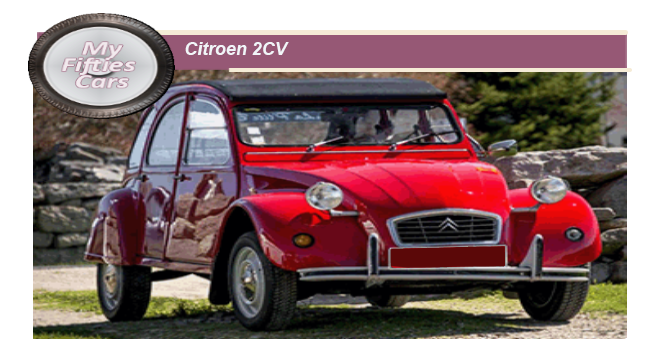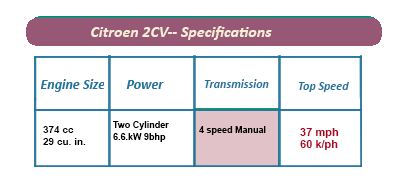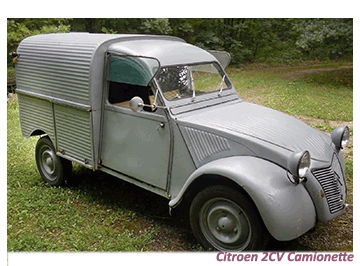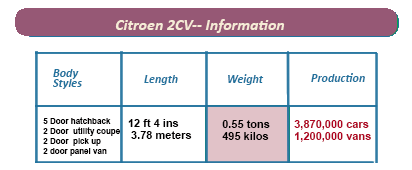 When launched in October 1948 at the Paris motor show, the 2CV (Deux Chevaux) the first new Citroen introduced after World War II certainly cut the imagination of the crowd.
When launched in October 1948 at the Paris motor show, the 2CV (Deux Chevaux) the first new Citroen introduced after World War II certainly cut the imagination of the crowd.
Reportedly under development for ten years, the Citroen 2CV was an exercise in simplicity, France's answer to the Volkswagen Beetle, Fiat 500 or Morris Minor, but much more fundamental and less pleasing to the eye.
The most po pular version of the 2CV was the five-door hatchback was with four doors, and room for four persons and their luggage.
pular version of the 2CV was the five-door hatchback was with four doors, and room for four persons and their luggage.
Initially, the 2CV came with a 375 cc twin-cylinder front wheel drive engine which was only capable of reaching a top speed of 60 kilometres an hour ( 37 mph).
Over the years Citroen's engineers gradually increased the 2CV's engine's power, with the car eventually fitted with a 602 cc air-cooled version, generating 29 bhp and reaching speeds not recommended on Frances' vast network of rural country roads.
The 2CV's suspension consisted of torsion bars and oversized shock absorbers all around, with leading arms in front and trailing arms at the rear.
 T Individual rods realigned the rear wheels as soon as the front wheels hit a bump.
T Individual rods realigned the rear wheels as soon as the front wheels hit a bump.
An automatic centrifugal clutch allowed two-pedal operation in traffic, with overdrive on the all-synchro three-speed (four with overdrive) manual gearbox. An L-shaped gearshift handle protruded from the dashboard.
![]()
The engine sat ahead of the front wheels, with its oil cooler placed above, inboard brakes behind, and the gearbox to the rear of the differential with even a built-in jacking system included.
 The only instruments were a speedometer and ammeter, while the car's parcel shelf was mounted below the cowl.
The only instruments were a speedometer and ammeter, while the car's parcel shelf was mounted below the cowl.
The 2CV's flat windshield and down-sloping hood allowed first class forward visibility, although vision was limited toward the rear.
From day one, it was evident that the 2CV was designed for comfort and not for speed, and unsightly as it was the car was a tremendous success, with an ongoing two-year waiting list to buy one.
Despite the unrelenting demand in the domestic market, by the early Fifties, Citroen began to develop an export market, with the 2CV proving very popular in Northern Europe, notably Holland and Belgium, because of the car's air-cooled engine.
 Orders for the 2CV flowed in, only because there was no better dual-purpose vehicle available at that time, with the French public drawn in by the price that Citroen were marketing the 2CV for at that point.
Orders for the 2CV flowed in, only because there was no better dual-purpose vehicle available at that time, with the French public drawn in by the price that Citroen were marketing the 2CV for at that point.
Among the intriguing features taht made the 2CV stand out from tje crowd were its quirky fabric top that rolled back as a massive sunroof: doors that slid off their hinges: seats that could be removed, and front fenders that could be replaced in around sixty seconds.
![]()
The 2CV's headlamps could be rapidly adjusted by turning a knob inside the car, while the windshield wipers operated by hand (or, if not, through the speedometer gear).
The 2CV was never designed to be a city car- instead, a workhorse for Northern Europe's still vast rural community, allowing many of them to own a vehicle for the first time, playing a tremendous part in helping the population of France get back on their feet after World War II. The Citroen 2CV, often described as an 'umbrella on four wheels, was capable of serving as an affordable multi-function passenger car, van, pickup truck, off-roader and small livestock transporter, capable of carrying people or cargo in bearable comfort along unpaved roads, and even across a ploughed field if need be. The first 2CVs were truly primitive workhorses, although over the years they gradually acquired a bit more finesse. Despite that there can be no detracting from the early Deux-Chevaux and the part that the model played in Northern Europe's motoring history, often described in the media as 'undoubtedly the most original design since the Model T Ford."
2CVs were truly primitive workhorses, although over the years they gradually acquired a bit more finesse. Despite that there can be no detracting from the early Deux-Chevaux and the part that the model played in Northern Europe's motoring history, often described in the media as 'undoubtedly the most original design since the Model T Ford."
 When production of the 2CV eventually wound down in 1990, over 3.2 million produced (plus 1.2 million versions of the Camionette truck ) flowing off the production lines from Citroen factories operating in six countries of the World.
When production of the 2CV eventually wound down in 1990, over 3.2 million produced (plus 1.2 million versions of the Camionette truck ) flowing off the production lines from Citroen factories operating in six countries of the World.


